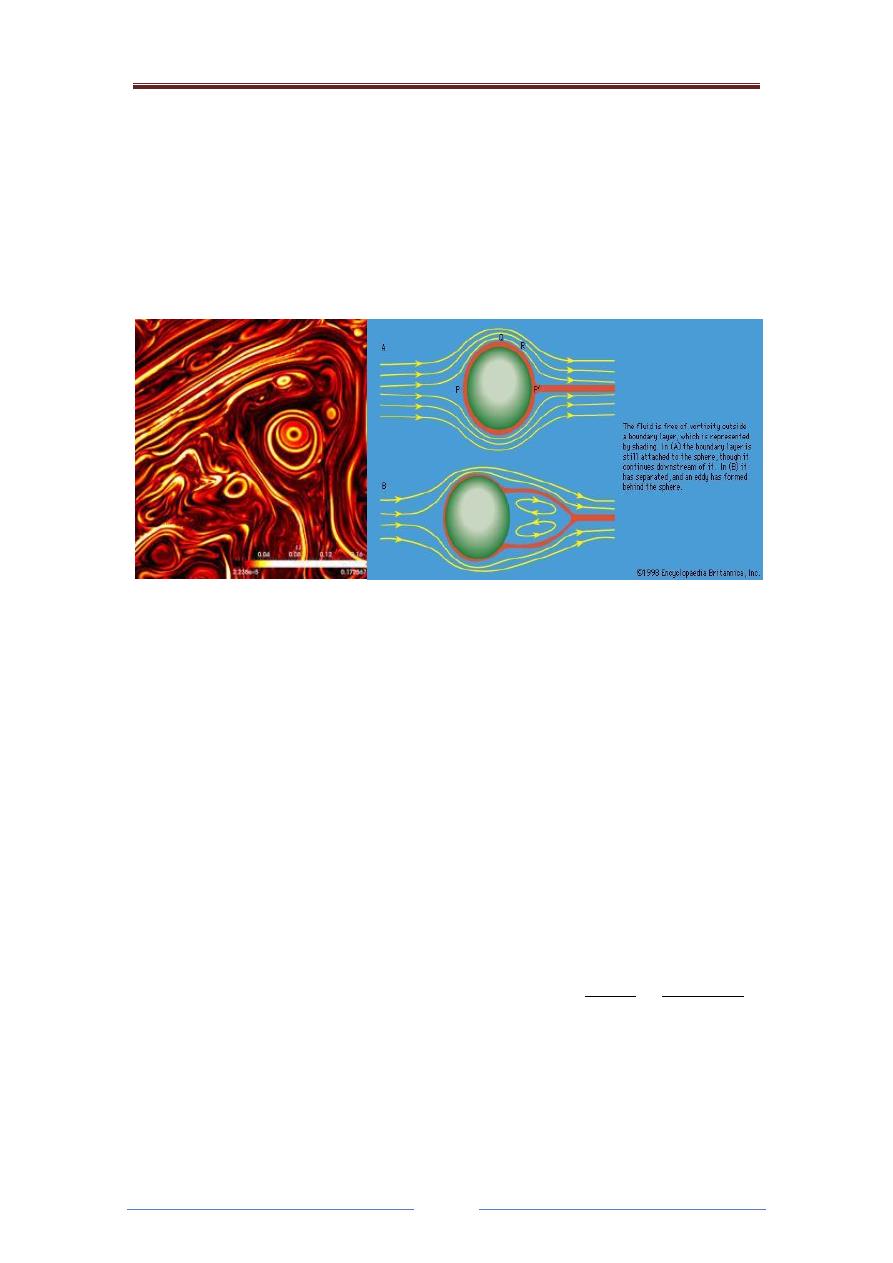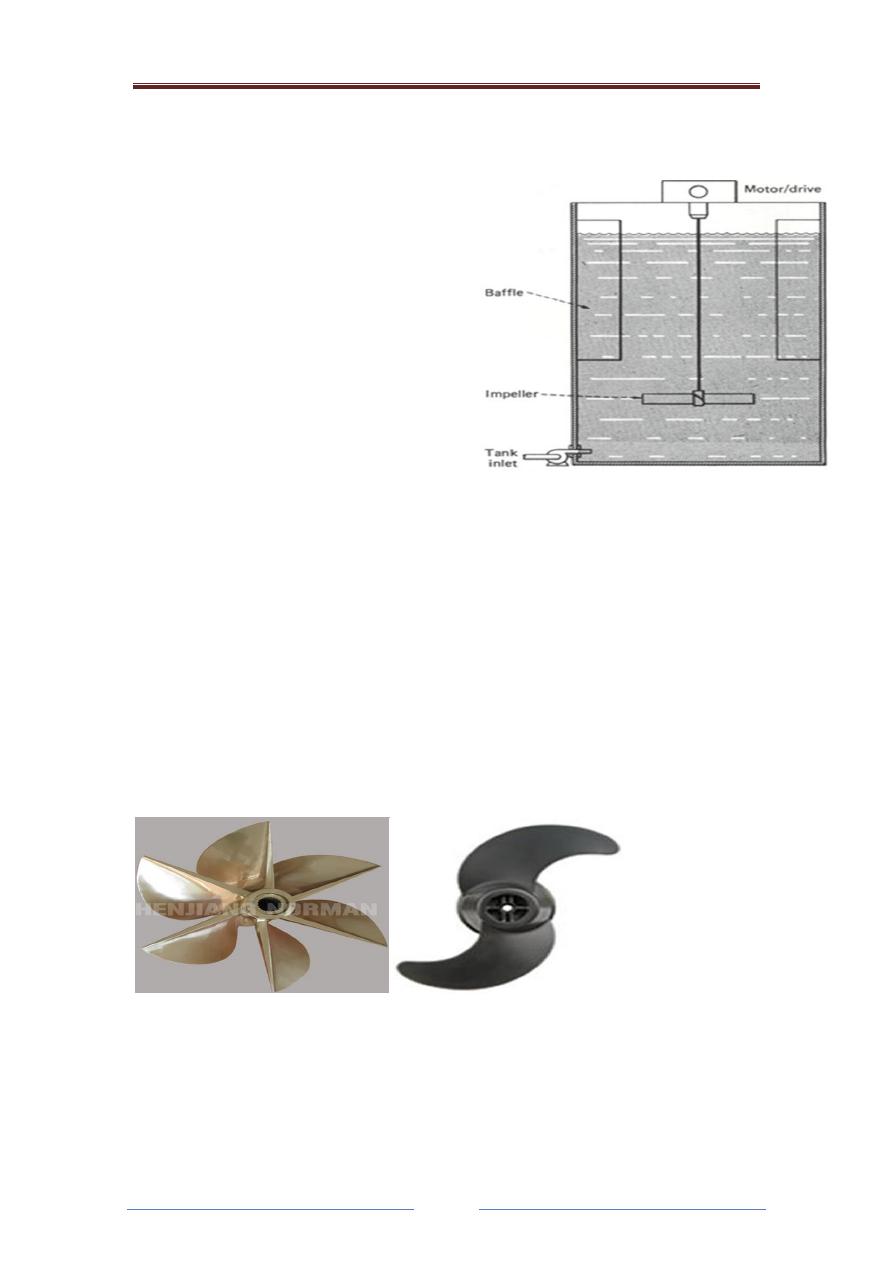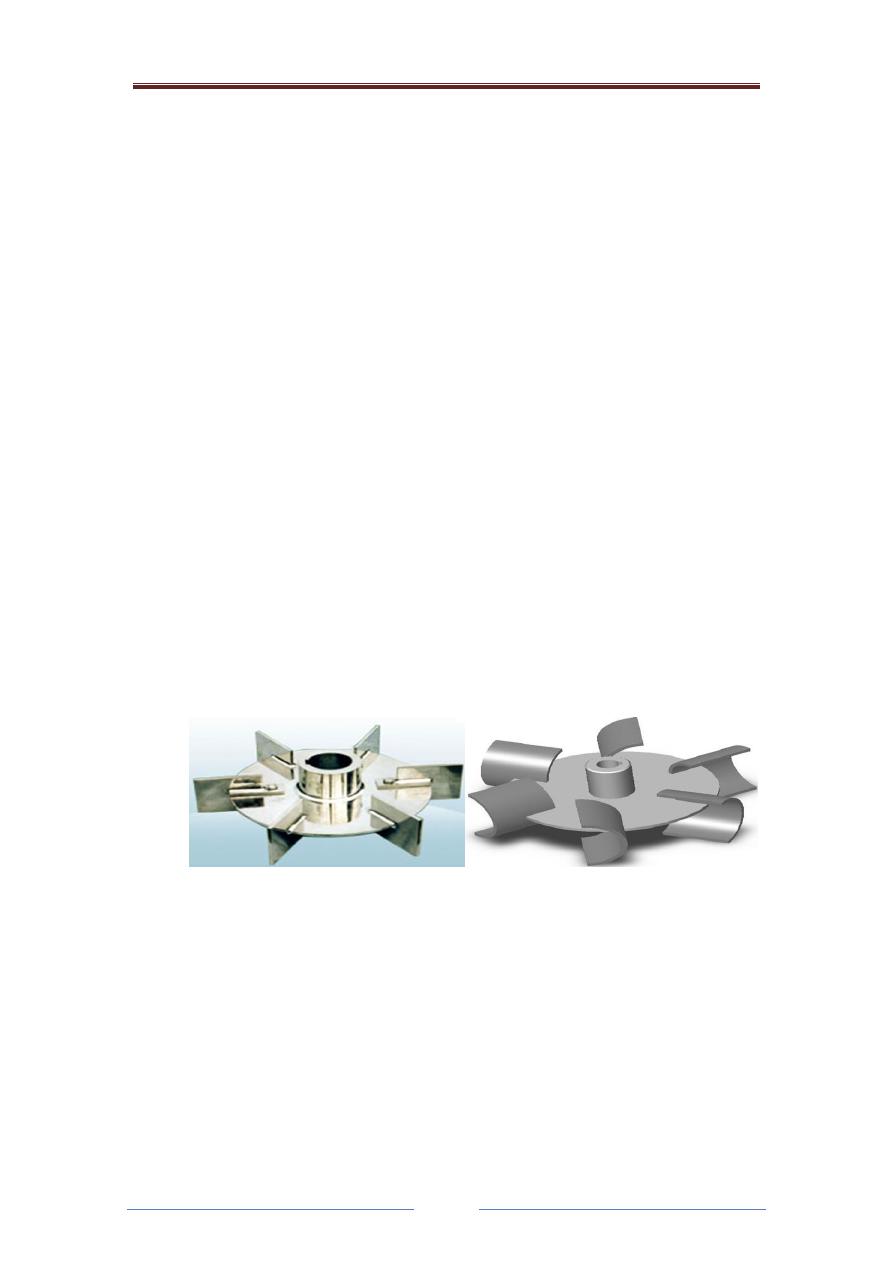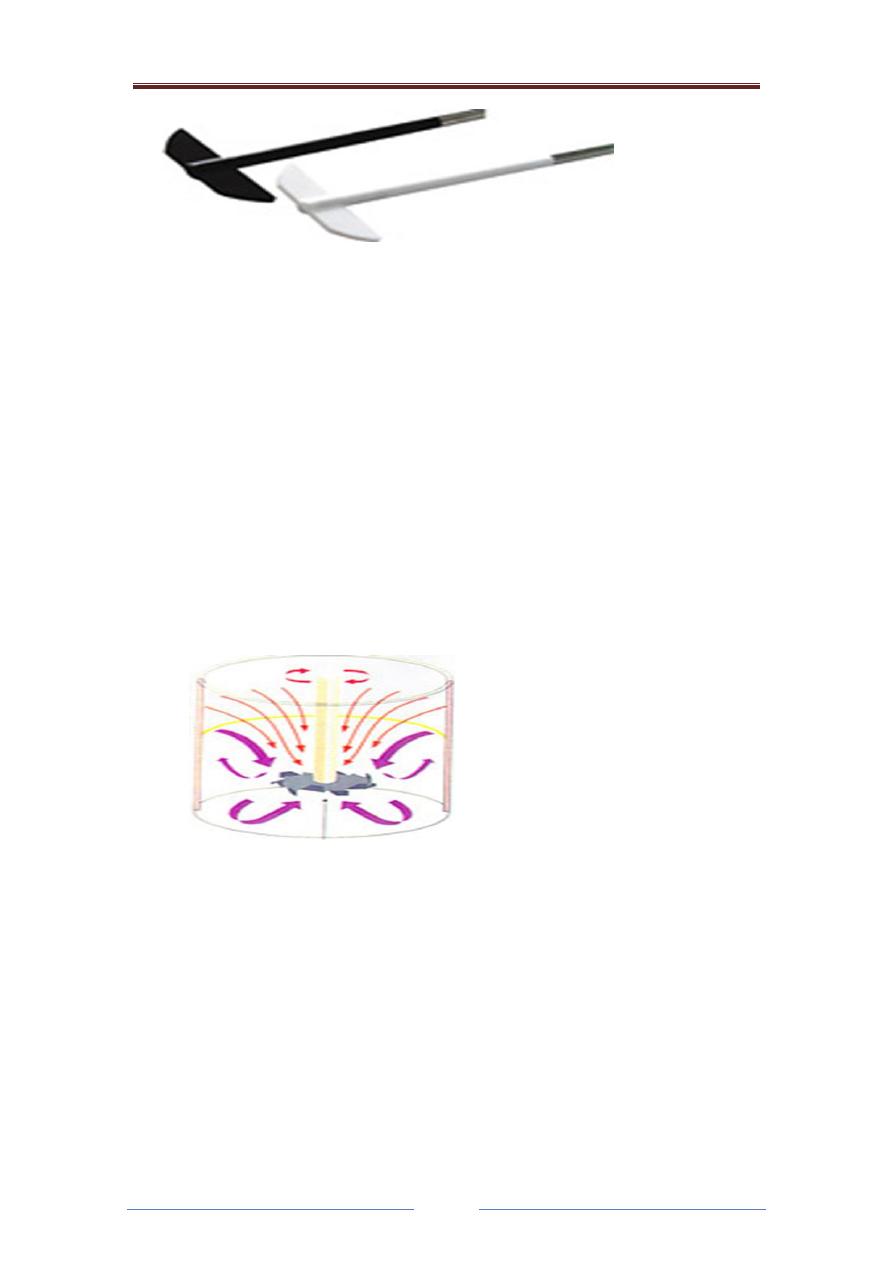
Industrial pharmacy Mixing I
Page 1
Mixing
The process of mixing is one of the most commonly employed
operations in everyday life. Owing in part to the almost limitless variety
of materials that can be mixed, much remains to be learned regarding the
mechanisms by which mixing occurs.
Mixing may be defined as the process in which two or more than two
components in a separate or roughly mixed condition are treated in such a
way so that each particle of any one ingredient lies as nearly as possible
to the adjacent particles of other ingredients or components. This process
may involve the mixing of gases, liquids or solids in any possible
combination and in any possible ratio of two or more components.
Mixing of a gas with another gas, mixing of miscible low viscosity
liquids and mixing of a highly soluble solid with a low viscosity liquid to
effect dissolution are relatively simple as compared to the mixing of
gases with liquids, mixing of liquids of high viscosity though miscible,
mixing of two immiscible liquids such as aqueous and oily solutions to
form emulsions, mixing of solids with liquids when the proportion of
solids is high and mixing of solids with solids, specialized equipments are
required for these operations.
Some of the examples of large scale mixing practiced in pharmacy are:
Mixing of powders in varying proportions prior to granulation or
tableting
Dry mixing of the materials for direct compression in tablets
Dry blending of powders in capsules and compound powders
(insufflations(
Blending of powders in cosmetics in the preparation of face
powders, tooth powders
Dissolution of soluble solids in viscous liquids for dispensing in
soft capsules and in the preparation of syrups
Mixing of two immiscible liquids for preparation of emulsions.
Depending on the flow properties of materials, solids are divided into two
types:
1. Cohesive materials - These are characterized by their resistance to
flow through openings for e.g. wet clay.

Industrial pharmacy Mixing I
Page 2
2. Noncohesive materials – These materials flow readily such as
grain, dry sand, plastic chips etc.
Mixing of cohesive materials is more difficult due to formation of
aggregates and lumps. Wet mixing is encountered in pharmacy as an
individual operation or as a subsequent step after dry blending.
In pharmaceutical practice, solid-solid, solid-liquid and liquid-liquid
mixing are generally batch operations where the batch may be as large as
one ton.
Objectives of mixing
Mixing can be done for the following reasons:
To ensure that there is uniformity of composition between the
mixed ingredients which may be determined by taking samples
from the bulk material and analyzing them, which should represent
overall composition of the mixture.
To initiate or to enhance the physical or chemical reactions e.g.
diffusion, dissolution etc.
Generally mixing is carried out to obtain following type of products
When two or more than two miscible liquids are mixed together,
this results in to a solution known as true solution.
When two immiscible liquids are mixed in the presence of an
emulsifying agent, an emulsion is produced.
When a solid is dissolved in a vehicle, a solution is obtained
When an insoluble solid is mixed with a vehicle, a suspension is
obtained.
When a solid or liquid is mixed with a semisolid base, an ointment
or a suppository is produced.
When two or more than two solid substances are mixed together, a
powder is obtained which when filled into capsule shell is known
as capsules and when compressed under heavy pressure is called
tablet.
Types of Mixtures
Mixtures may be classified as follows:
1. Positive mixtures

Industrial pharmacy Mixing I
Page 3
2. Negative mixtures
3. Neutral mixtures
I. Positive Mixtures – These types of mixtures are formed when two or
more than two gases or miscible liquids are mixed together by means of
diffusion process. In this case no energy is required provided the time
allowed for solution formation is sufficient. These types of materials do
not create any problem in mixing.
II.Negative Mixtures – These types of mixtures are formed when
insoluble solids are mixed with a vehicle to form a suspension or when
two immiscible liquids are mixed to form an emulsion. These mixtures
are more difficult to prepare and require a higher degree of mixing with
external force as there is tendency of the components of these mixtures
separate out unless they are continuously stirred.
III. Neutral Mixtures – Many pharmaceutical products such as pastes,
ointments and mixed powders are the examples of neutral mixtures. They
are static in their behavior. The components of such products do not have
any tendency to mix spontaneously but once mixed, they do not separate
out easily.
I. Liquid mixing
Liquid mixing may be divided into following two subgroups:
1. Mixing of liquids and liquids
a) Mixing of two miscible liquids
b) Mixing of two immiscible liquids
2. Mixing of liquids and solids
a) Mixing of liquids and soluble solids
b) Mixing of liquids and insoluble solids
1. (a) Mixing of two miscible liquids (homogeneous mixtures e.g.
solutions) – mixing of two miscible liquids is quite easy and occur by
diffusion. Such type of mixing does not create any problem. Simple
shaking or stirring is enough but if the liquids are not readily miscible or
if they have very different viscosities then electric stirrer may be used.

Industrial pharmacy Mixing I
Page 4
Sometimes turbulence may be created in the liquids to be mixed.
Turbulence is a function of velocity gradient between two adjacent layers
of a liquid. Thus if a rapidly moving stream of liquid is in contact with a
nearly stationary liquid, there will be high velocity gradient at the
boundary which results in tearing off portions of the faster moving stream
and sending it off to the slower moving areas as vortexes or eddies. These
eddies persists for some time and ultimately dissipate themselves as heat.
This results also in drawing in part of the slow moving liquid into a
high velocity liquid because of differences in static pressures created as in
an ejector. Most of the mixing equipments are designed on the basis of
providing high local velocities but directing them in such a manner that
they will ultimately carry their own turbulence or the turbulence of the
eddies they create, throughout the mass to be mixed
1.(b) Mixing of two immiscible liquids (heterogenous mixtures e.g.
emulsions) – two immiscible liquids are mixed to effect transfer of a
dissolved substance from one liquid to another an eg. of such type of
mixing is the extraction of penicillin in the acid form from aqueous
solution into the organic solvent amyl acetate, to promote a chemical
reaction after transfer of a component, to allow transfer of heat from one
liquid to the other or to prepare emulsion. When two immiscible liquids
are mixed together in the presence of an emulsifying agent an emulsion is
produced. For the production of a stable emulsion, the mixing must be
very efficient i.e. continuous without ceasing because the components
tend to separate out if continuous work is not applied on them.

Industrial pharmacy Mixing I
Page 5
Mixing occurs in two stages:
1. Localized mixing in which shear is applied to the particles of the
liquid
2. A general movement sufficient to take all the particles of the
materials through the shearing zone so as to produce a uniform
product.
On small scale, for the preparation of emulsions, a pestle and mortar is
quite suitable. Here, shear forces are produced between the flat head of
the pestle and the flat bottom of the mortar whereas a general movement
is produced by continuous movement of the pestle along the sides of the
mortar by which the sticking material to the sides is returned to the
bottom of the mortar.
Generally emulsions are prepared in two stages (i) primary emulsion (ii)
secondary emulsion. In the primary stage the two immiscible liquids are
triturated with an emulsifying agent to get a primary emulsion, which is
further diluted by adding more of vehicle. After the preparation of an
emulsion which is coarse in nature may be passed through a homogenizer
to get a homogeneous emulsion of desired particle size.
2. (a) Mixing of liquids and soluble solids (homogeneous mixtures e.g.
solutions)- in this case soluble solids are dissolved in a suitable liquid by
means of stirring. It is a physical change i.e. a soluble solid is converted
to a solution.
2.(b) Mixing of liquids and insoluble solids (heterogeneous mixtures
e.g. suspensions) – when insoluble solids are mixed with a liquid a
suspension is produced which is an unstable system. The ingredients of a
suspension separate out when allowed to stand for some time. Thus a
suspending agent is required to produce a stable suspension. On small
scale, suspensions may be prepared in a pestle and mortar.
If the aim of the mixing process is simply to produce a blend of two
liquids that are readily miscible or to form a solution of a solid in liquid
then flow alone may be sufficient . when the aim of mixing is to produce
an emulsion from two immiscible liquids, shear forces being essential.

Industrial pharmacy Mixing I
Page 6
Mixing mechanisms:
for fluids fall essentially into four categories: bulk transport, turbulent
flow, laminar flow, and molecular diffusion. Usually more than one of
these processes is operative in practical mixing situations.
1.Bulk transport – the movement of a relatively large portion of the
material being mixed from one location in the system to another
constitutes bulk transport. A simple circulation of material in a mixer may
not necessarily result in efficient mixing. For bulk transport to be
effective it must result in a rearrangement or permutation of the various
portions of the material to be mixed. This can be accomplished by means
of paddles, revolving blades, or other devices within the mixer arranged
so as to move adjacent volumes of the fluid in different directions,
thereby shuffling the system in three dimensions.
2.Turbulent Mixing – the phenomenon of turbulent mixing is a direct
result of turbulent fluid flow, which is characterized by a random
fluctuation of the fluid velocity at any given point with in the system. The
fluid velocity at a given instant may be expressed as the vector sum of its
components in the x, y, and z directions. With turbulence, these
directional components fluctuate randomly about their individual mean
values, as does the velocity itself. In general, with turbulence, the fluid
has different instantaneous velocities at different locations at the same
time. This observation is true for both, the direction and the magnitude of
the velocity. If the instantaneous velocities at two points in a turbulent
flow field are measured simultaneously, they show a degree of similarity
provided that the points selected are not too far apart. There is no velocity
correlation between the points, however, if they are separated by a
sufficient distance.
Turbulent flow can be conveniently visualized as a composite of eddies
of various sizes. An eddy is defined as a portion of fluid moving as a unit
in a direction often contrary to that of the general flow. Large eddies tend
to break up; forming eddies of smaller and smaller sizes until they are no
longer distinguishable. The size distribution of eddies within a turbulent
region is referred to as the scale of turbulence. It is readily apparent that
such temporal and spatial velocity differences, as a result from turbulence
within a body of fluid produce a randomization of the fluid particles. For

Industrial pharmacy Mixing I
Page 7
this reason, turbulence is a highly effective mechanism for mixing. Thus,
when small eddies are predominant, the scale of turbulence is low.
3.Laminar mixing – Streamline or laminar flow is frequently
encountered when highly viscous liquids are being processed. It can also
occur if stirring is relatively gentle and may exist adjacent to stationary
surfaces in vessels in which the flow is predominantly turbulent. When
two dissimilar liquids are mixed through laminar flow, the shear that is
generated stretches the interface between them. If the mixer employed
folds the layers back upon themselves, the number of layers, and hence
the interfacial area between them, increase exponentially with time.
4.Molecular diffusion – The primary mechanism responsible for mixing
at the molecular level is diffusion resulting from the thermal motion of
the molecules. When it comes in conjunction with laminar flow,
molecular diffusion tends to reduce the sharp discontinuities at the
interface between the fluid layers, and if allowed to proceed for sufficient
time, results in complete mixing. The process is described quantitatively
in terms of Fick’s law of diffusion:
Dm/dt = -DA dc/dx
Where, the rate of transport of mass, dm/dt across an interface of area A
is proportional to the concentration gradient, dc/dx, across the interface.
The rate of intermingling is governed also by the diffusion coefficient, D,
which is a function of variables including fluid viscosity and size of the
diffusing molecules. The concentration gradient at the original boundary
is a decreasing function of time; approaching zero as mixing approaches
completion.
Rate of Mixing
Mixing is the process of achieving uniform randomness of the mixed
components, which on subdivision to individual doses contains the
correct proportions of each component which depends on the amount of
mixing done.
In the early stages of mixing, the rate of mixing is very fast because the
mixing particles change their path of circulation quickly and find
themselves in different environment whereas at the end of the process

Industrial pharmacy Mixing I
Page 8
rate of mixing reaches to almost zero because the particles do not find
different environment.
Mixing Apparatus for fluids
A Container and
A Mixing Device or Impeller
Based on shape and pitch , impellers
are classified into 3 types ,
1. Propellers
2. Turbines
3. Paddles
1-propeller
• It consists of number of blades, generally 3 bladed design is most
common for liquids. Blades may be right or left handed depending
upon the slant of their blades.
• Two are more propellers are used for deep tank.
• Size of propeller is small and may increase up to 0.5metres
depending upon the size of the tank.
• Small size propellers can rotate up to 8000rpm and produce
longitudinal movement
Advantages of propellers:
1. Used when high mixing capacity is required.
2. Effective for liquids which have maximum viscosity of
2.0pascals.sec or slurry up to 10% solids of fine mesh size.

Industrial pharmacy Mixing I
Page 9
3. Effective gas-liquid dispersion is possible at laboratory scale.
Disadvantages of propellers:
1. Propellers are not normally effective with liquids of viscosity
greater than 5pascal.second, such as glycerin castor oil, etc.,
2-Turbine
• A turbine consists of a circular disc to which a number of short
blades are attached. Blades may be straight or curved.
• The diameter of the turbine ranges from 30-50% of the diameter of
the vessel.
• Turbines rotates at a lower speed than the propellers (50-200rpm).
• Flat blade turbines produce radial and tangential flow but as the
speed increases radial flow dominates. Pitched blade turbine
produces axial flow.
• Near the impeller zone of rapid currents, high turbulence and
intense shear is observed. Shear produced by turbines can be
further enhanced using a diffuser ring (stationary perforated ring
which surrounds the turbine).
Advantages of Turbines:
• Turbines give greater shearing forces than propellers through the
pumping rate is less. Therefore suitable for emulsification.
• Effective for high viscous solutions with a wide range of
viscosities up to 7.0 Pascal. Second.
• In low viscous materials of large volumes turbine create a strong
currents which spread throughout the tank destroying stagnant
pockets.

Industrial pharmacy Mixing I
Page
10
• They can handle slurries with 60% solids.
• Turbines are suitable for liquids of large volume and high
viscosity, if the tank is baffled.
3-Paddle
• A paddle consists of a central hub with long flat blades attached to
it vertically.
• Two blades or four blades are common. sometimes the blades are
pitched and may be dished or hemispherical in shape and have a
large surface area in relation to the tank in which they are used.
• Paddles rotates at a low speed of 100rpm.
• They push the liquid radially and tangentially with almost no axial
action unless blades are pitched.
• In deep tanks several paddles are attached one above the other on
the same shaft.
• At very low speeds it gives mild agitation in unbaffled tank but as
for high speeds baffles are necessary.
Uses of paddles:
• Paddles are used in the manufacture of antacid suspensions, agar
and pectin related purgatives, antidiarrheal mixtures such as
bismuth-kaolin.
Advantages of paddles:
• Vortex formation is not possible with paddle impellers because of
low speed mixing.
Disadvantages of paddles:
• Mixing of the suspension is poor therefore baffled tanks are
required.

Industrial pharmacy Mixing I
Page
11
Liquid mixing is usually performed with a mixing element, commonly a
rotational device, which provides the necessary shear forces, but is of
suitable shape to act as an impeller to produce an appropriate pattern in
the mixing vessel. The movement of the liquid at any point in the vessel
will have three velocity components and the complete flow pattern will
depend upon variations in these three components in different parts of the
vessel.
The three velocity components are;
1. Radial components
Acts in the direction vertical to the impeller shaft. Excessive radial
flow takes the material to the container wall then material falls to
the bottom and rotate as the mass beneath the impeller
2. A tangential component
Acts in the direction tangent to the circle of rotation around the
impeller shaft. If shaft is placed vertically and centrally, tangential
flow follows a circular path around the shaft and creates a vortex in
the liquid.

Industrial pharmacy Mixing I
Page
12
3. Axial component or longitudinal or vertical: Acts in the direction
parallel to the impeller shaft. Inadequate longitudinal component
causes the liquid and solid to rotate in layers without mixing.
Adequate longitudinal pattern is best used to generate strong
vertical currents particularly when suspending solids are present in
a liquid.
Impeller type
Flow component
Propellers
Axial
Turbines
Axial or tangential or both
Paddles
Radial and tangential
Paddles with pitch
Radial, tangential and axial
